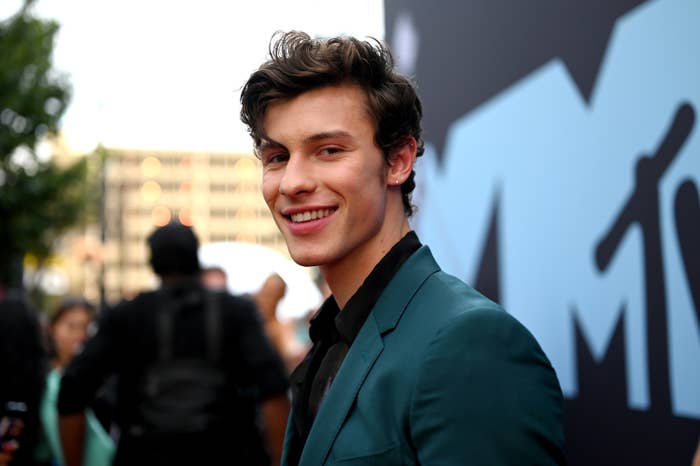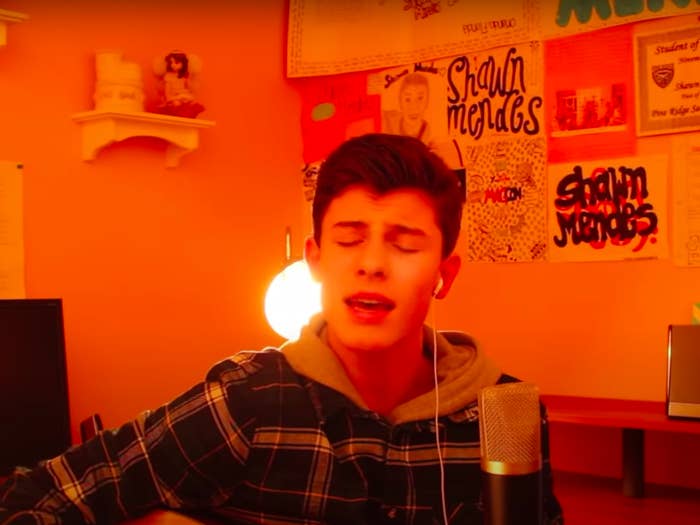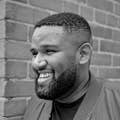
There is a simple pleasure to good YouTube covers. Their job is to offer a slightly different but ultimately inoffensive variation of something you already like. The medium has the vibe of a house party where someone picked up a guitar to sing some songs that definitely won’t ruin the night. The safety is built in: Even if you don’t absolutely love it, it probably won’t be a waste of your time. And there are so many if decent enough covers to listen to.
I know this because I just fell down that rabbit hole. Again. I was inspired by a small moment from In Wonder, the Shawn Mendes documentary released on Netflix in late November, ahead of the pop sensation’s fourth album, Wonder. In the doc, Mendes’s manager Andrew Gertler shares that he offered to sign Mendes in 2013 after watching the then-teen cover “Say Something” by A Great Big World.
And so off to YouTube I went to find this allegedly arresting artifact. And look, the cover is fine. “Hey guys, it’s Shawn Mendes here,” it opens cheerfully, the way all YouTube covers do. Mendes gives a serviceable take on a forgettable pop song, while above him hangs a certificate for “Student of the Month” from his high school. “Face of the future,” it reads.
In the video, Mendes shows a raw vocal talent even if there’s little charisma to be found. But this scarcely matters: in 2013, Mendes was an online juggernaut, boasting millions of followers on Vine and YouTube. He was singing the songs of Adele, Rihanna, OneRepublic, Lana Del Rey — basically any artist you’d type “[artist name] cover” into the YouTube search bar. His covers were as universal as the radio: If there was an audience for it, Mendes covered it.
Fast-forward to now, and Mendes is not much about that YouTube life anymore. In the intervening years, three of his albums have debuted at No. 1 on the Billboard pop charts, and Mendes has become one of only a handful of artists to have more than one album at #1 before their 18th birthday. He’s had a No. 1 song (“Señorita”). He has sold out arenas.
But what his career has not included is...anything definable? Mendes has managed to do all of this without ever landing on much of a public personality. What the fuck is Shawn Mendes’s deal, people wonder. Sure, he’s clean cut and appears to always be smiling, but no one knows much of anything about him. Instead, everything about his career so far seems executed according to a playbook, a series of moves plotted out a decade ago.
As a sales phenomenon, as a veritable chart-topper, Mendes can’t miss. In December, Wonder debuted at — surprise! — No. 1. But underneath the steady chart success, it’s clear that Mendes is trying to become more than anonymous, more than a vaguely likable undefined pop blob. And inside a broadly catchy but uninteresting record, there are brief flashes of the ghost inside the machine.

In the post–Justin Bieber gold rush of the late aughts and early 2010s, a sturdy social media following was enough to get a record deal. The pop group 5 Seconds of Summer came up that way. So did the Weeknd. Alessia Cara too. And so did Shawn Mendes.
The teen from Pickering, Ontario — just outside Toronto — built his following on Vine, with charming six-second covers, just long enough to recognize the song, not nearly long enough to discern anything about the person singing them. The one that put him on the map was a brief cover of Bieber’s “As Long As You Love Me,” because of course it was. He gained 10,000 followers literally overnight, and the Mendes rocket took off.
The guy had a No.1 album but still spent that year doing more covers: Sheeran, One Direction, Bieber.
In the early days of chaotic online fandom (remember “Vine meetups”????), Mendes’s sweet voice and good looks made him an easy star. At conventions and meet-and-greets of online celebrities, teens gathered around him as he sang efficient covers of their favorite songs. The social media attention translated to a record deal, and before long, he released his debut album, 2015’s Handwritten.
It was a straightforward pop rock album, what you might expect if you pickled John Mayer in Ed Sheeran for a week or two. The New York Times observed that his brand of guitar dude pop rock was aimed “primarily to tweens and teenagers” but it also found success with “the dentists’ office demographics.”
In other words, the album was a safe pitch straight down the middle to the pop machine. It could’ve easily blended in with the rest of the grist for radio mill, but there was something buoyant about Mendes. His propulsive vocals made him stand out. You hear this on “Stitches” — he strains to reach the highest notes, and in the straining he finds distinction: Here was a guy willing to at least go for it, to reach and reach the upper ends of his abilities. He may not be polished, but he was compelling to listen to.
Buzz begets buzz, and Mendes landed an opening slot supporting Taylor Swift on tour. Handwritten debuted at No. 1, setting up an immediate comparison: Mendes was the youngest person since Justin Bieber to have a No. 1 album.
But that’s roughly where the contrast ended. In 2009, Bieber had a basic sales concept — the kid wonder discovered by Usher, with the vibe of your friend’s mischievous little brother. By way of image-making, Mendes had none. He was a baby-faced aw-shucks type of star, with not a lot to say. Part of this is the Vine training grounds: With online stardom, the presence is the gift. Prior to signing for a major label, Mendes didn’t have to do much talking — he need only show up, wave, and strum his guitar and people would start screaming before he’d launch into a cover. Fitting then, that on the press tour, he performed covers. He seemed most comfortable in his YouTube stardom mode. The guy had a No.1 album but still spent that year doing more covers: Sheeran, One Direction, Bieber.
2016’s Illuminate — still his best offering — was a refinement of the sound he had developed on Handwritten. The album debuted at No. 1 too and established Mendes as a contender for big-league stardom. The songs gently expanded his musical palette. He used his voice as an emotional center, infusing ordinary pop songs with vocals that packed wattage well beyond his years.
There he goes on “Treat You Better,” showboating with the way the verse reaches for the chorus. On “There’s Nothing Holding Me Back,” he is redlining, pushing against the edges of his voice. He punctures his own limitations at the end of the bridge on “Mercy.” You’d want to hand him a lozenge, but you’d tell all your friends: Shawn Mendes fuckin’ goes.
Though the album’s lyrics occasionally pushed into moderately more risque territory, Mendes himself remained stubbornly milquetoast. On the heels of its release, he told the New York Times, “I’ve never had a scandal, but I don’t know if that’s so much because I’m perfect, or because people aren’t caring enough yet.”
Eventually, every megastar is going to need a gimmick. This is not sinister — it’s just an accepted mechanism for audiences to remember them. Ed Sheeran managed to convince people he’s an underdog, that he’s not beautiful. Harry Styles leans into his sex appeal, accentuates it.
In 2018, the Mendes story was that he’s now grown. At all of 20 years old, the sales pitch was that Mendes was no longer a teen sensation, but now a man. He did a Calvin Klein shoot, presumably for the subtext that ya boy now fucks. Even Jennifer Lopez was thirsting. When he ended up on Time’s 100 most influential people, his tribute, written by — who else — John Mayer, read that “his physique falls somewhere between fitness model and party trick.”
He also made the third album self-titled, because he’s serious now. Grown-man shit. He allowed himself to flirt with other genres — here we have clear R&B influences, there some pulsating, vamping, outright horny tracks. He also opened up his creative circles, allowing the likes of Julia Michaels and Ryan Tedder to contribute songs to the album. Ed Sheeran contributed one too, and John Mayer produced a track because, well, this was a grown-man album, from a grown man who hangs around other grown men.
Shawn Mendes was an experiment in opening up further lanes for its star, but in broadening the road, he lost his own sound. The fundamental elements of what made Mendes compelling were not particularly present on the record. Jon Caramanica noted that Mendes had lost his edge, with an album that is “full of pleasantly anonymous songs that systematically obscure Mr. Mendes’s talents.”
The importance of this is relegated solely to the Music Criticism Universe, because out there in the real world, folks were buying into the Mendes machine in droves. Mendes jetted off to a five-leg, 100-plus show tour that grossed nearly $100 million. Somewhere in the middle of that tour, in mid-2019, tabloids breathlessly reported that Mendes was now dating Camila Cabello.

Or...was it dating? There is no getting around it: Celebrities dating celebrities is both extremely likely and also extremely good for business. You get two SEO bumps for the price of one! And boy did they get headlines for kissing, kissing everywhere. But from the start, skeptics pointed out that their whole relationship seems a little...staged.
History is on the side of the skeptics. Mendes and Cabello collaborated for “I Know What You Did Last Summer,” a smash off of Mendes’s first album, and since their collaboration, fans of both camps have been shipping the relationship. The Good Ship #Shamila has existed for at least four years prior to the actual Shamila. It felt rather choreographed and convenient.
When the pair took the stage at the VMAs in August 2019 to perform their duet “Señorita,” the couple didn’t kiss, perhaps as a tease. Joe Jonas and Sophie Turner seemed upset about it. It was something for people to hook onto: we still didn’t know much about Mendes, but the forcefully publicized public displays of affection put a color on the blank Mendes canvas. Watching what was supposed to be a “steamy” performance of two young hot celebrities in love, the internet noted the “church camp counselor” energy of it all. But hey, at least someone noted something.
There’s a sweet moment in In Wonder, the documentary, where Mendes reveals that he told Cabello that when any song of his comes on the radio, “I’m like, ‘Everything is about you, they’ve always been about you….They’re all about you. Like, every song I ever wrote.”
It’s cute. It’s also obviously not true. It’s the kind of hyperbole that transparently reads as a doubling down: If the relationship makes people talk, let’s give ’em something to talk about. Cabello herself features prominently in the documentary, including a tender moment as they rehearse for their VMA performance. “Let’s sing another song. What’s a song for fun?” she urges Mendes. He launches into the opening notes of John Mayer’s “Slow Dancing in a Burning Room” (of course), and she responds with verve: “Fuck yeah!”
Not only is Cabello a recurring character in the documentary, she is one of the engines of the album Wonder. From “24 Hours,” a bright song ostensibly about a mortgage, to “Teach Me How to Love,” Mendes’s first credibly sexy song, the record portrays a singer deeply in love, and he wants to tell you about it. Folks: We got an angle.
The songs that aren’t about Cabello are about his other long-term relationship: fame. Mendes has been open about his struggles with fame. On “Call My Friends,” he is lonely and wistful. On “Song for No One,” he is lonely and sorrowful. On “Monster,” which features Justin Bieber, he is lonely and wary. Guys, I think Shawn Mendes might be lonely.

The fame-is-lonely trope is not new. But Mendes’s flavor of it manifests as particularly vague musings on the trouble with being asked to speak before you have something to say. In that way, the Bieber collaboration is a full-circle moment: In November, Mendes told Zane Lowe, “I was 9 when [Bieber’s] ‘One Time’ came out, and I completely was all in. He was Elvis to me.” Now they trade pouty lines in a moody music video for Monster: “What if I, what if I trip / What if I, what if I fall?/ Then am I the monster?”
In the song, Bieber tells us, “I was 15 when the whole world put me on a pedestal.” His mistakes have been public, the press unforgiving. By contrast, Mendes presents an anxiety about losing all of the fame, perhaps because he is unsure how he got it. He’s scandal-free, and for the most part, identity-free, too. A career so far reliant on safety and good charm, not unlike the mechanics of a good YouTube cover.
If the relationship makes people talk, let’s give ’em something to talk about.
The job of the celebrity documentary is to build a narrative around an artist in a way that the music alone can never manage. On this account, In Wonder broadly fails to be much more than a visual companion piece to the album, a tediously long music video — save for a couple of moments.
In one, we see Mendes after he is given doctor’s orders not to sing — actually, not even talk — in order to avoid damaging his voice. A shattered Mendes is in tears. He uses a text-to-speech program to tell the audience: “These next 10 years are when everything I do is going full speed. It’s like an athlete in their prime. I have to keep going.” That this is delivered by a robotic voice is a little on the nose, given that its would-be speaker is betraying the existence of a known and familiar trajectory of stardom.
In the other, we see Mendes noticeably come alive when he stops talking about fame, or touring, or romance, or even music. It’s a simple moment, where he is back in his hometown, and he takes the documentary crew to an open field. It is just a field. But he is ecstatic there, more of a person than we’ve seen him be over the rest of the documentary. He FaceTimes his best friend. “I took them to the turf, bro!” he exclaims. In the same field, his sister reveals that when Mendes was younger, he never wanted to be famous. “Well,” he says, “I obviously changed my mind.”
But did he? Mendes once had a policy of never denying a photo request. On a December episode of Dax Shepard’s podcast Armchair Expert, Mendes reveals that because of this policy, he once lined up 2,000 fans waiting outside a hotel, and took a selfie with every single one of them. He notes that now he’d rather have a five-minute conversation with two fans because it’s “more real.”
In the Shepard interview, Mendes comes off as sincere and earnest. It’s the most open he’s been in any interview I’ve come across, including the documentary about his own career. Something about not having to preface the weirdness of being famous to the interviewer seems to unlock Mendes, and he relaxes. “I do this thing,” he says, “where I desperately reach out to any celebrity who I think has figured out how to be a celebrity and be normal at the same time.” He has asked Mila Kunis and Ashton Kutcher, he says. Shepard suggests that he consult Sting.
The documentary concludes with Mendes messing around on the piano, singing an early version of what would become the album’s first track, “Intro.” He comes up with a lovely little lyric, tentative and fragile and open-ended: “You’ve been a million different places / still unsure where it’ll end / stuck in wonderland.”
By the time a version of “Intro” makes it onto the album, what might have been an honest impulse has been killed when the big pop song writing machine went brrr. The lyrics are a little less tentative, and much more optimistic: “You’ve been a million different places / so give yourself a chance / to get lost in wonderland.”
Giddily lost or anxiously stuck? Here is the tension. With Wonder, Mendes is telegraphing unease with superstardom while faithfully carrying out its duties. It’s an album in limbo, an attempt to have it both ways. “If I tell the world I’m just a normal human, will they stop coming to the shows and will they stop listening to the music? Will all the craziness stop?” he wonders in a documentary that he executive produced. The cognitive dissonance is real: It makes sense to call it “craziness” and still not be sure if you want it to end.
At the end of the record is a short acoustic song. “Can’t Imagine” is a little contemplative, a little saccharine. “I can’t imagine what a world would be without you,” Mendes sings. “All the birds would stop their songs / without you / all things right would feel so wrong.”
There is not much noteworthy about the song, except this: In the writer's credit field, it contains just one name — Mendes. It may not sound like much, but it’s from Mendes, all on his own. It seems in all the trappings of manufactured stardom, Mendes found a moment to plant a piece of himself. One wonders what will grow there. ●
